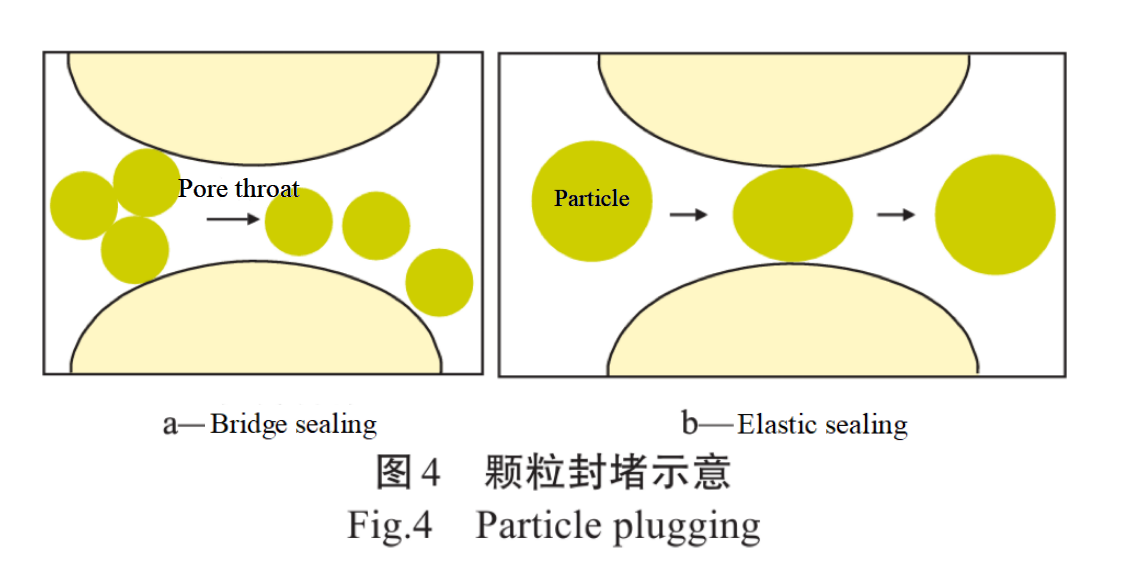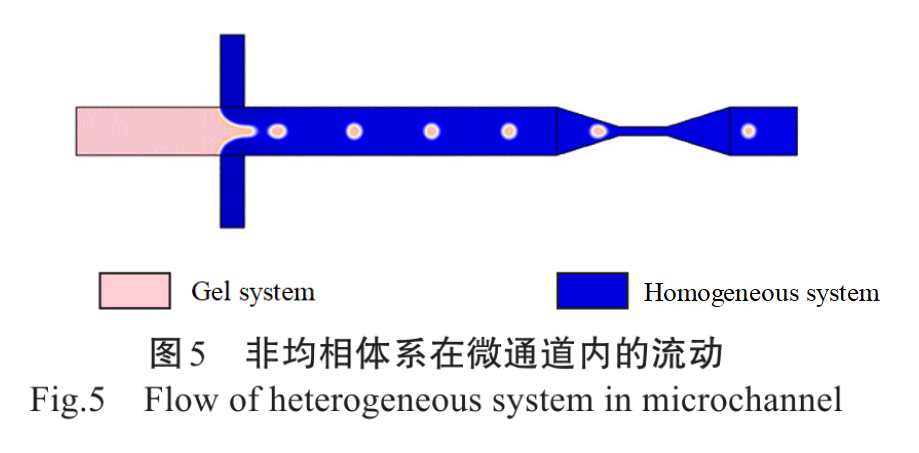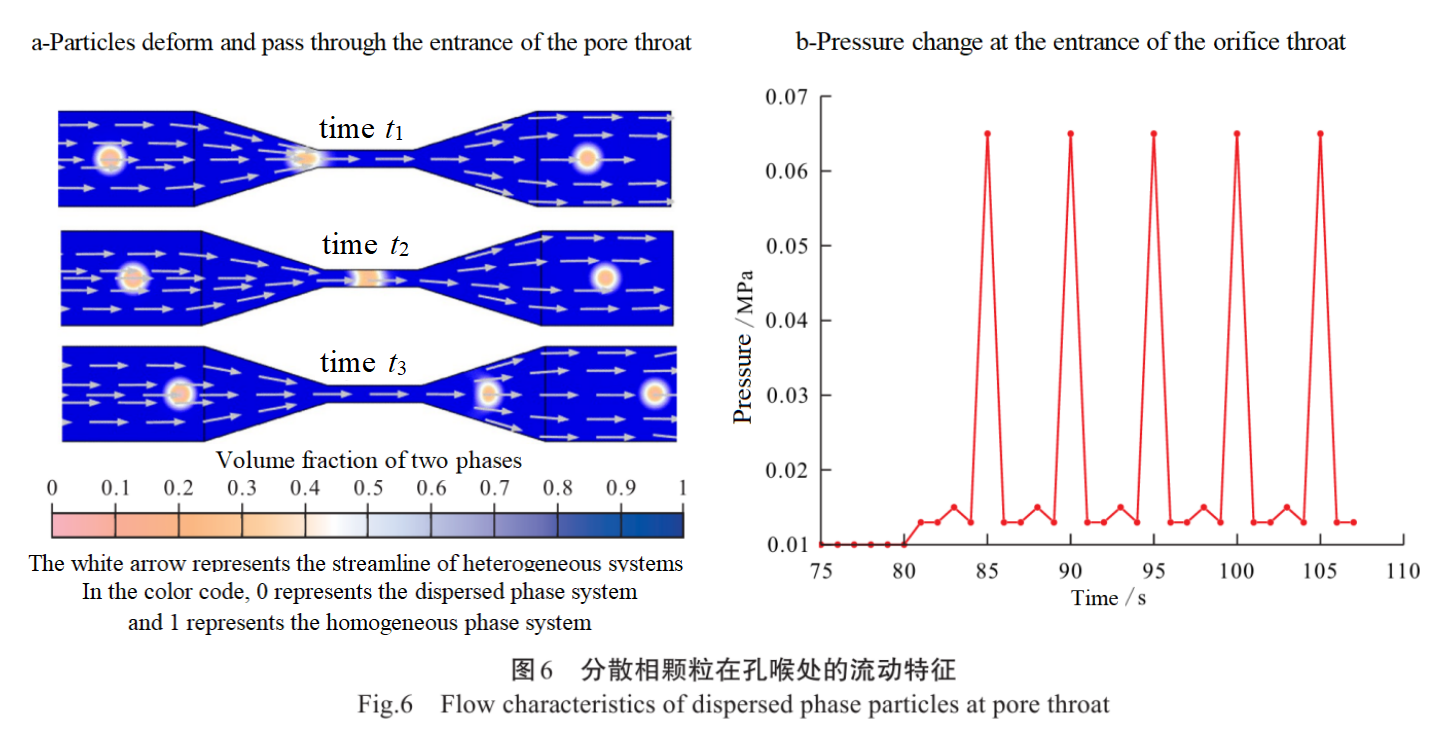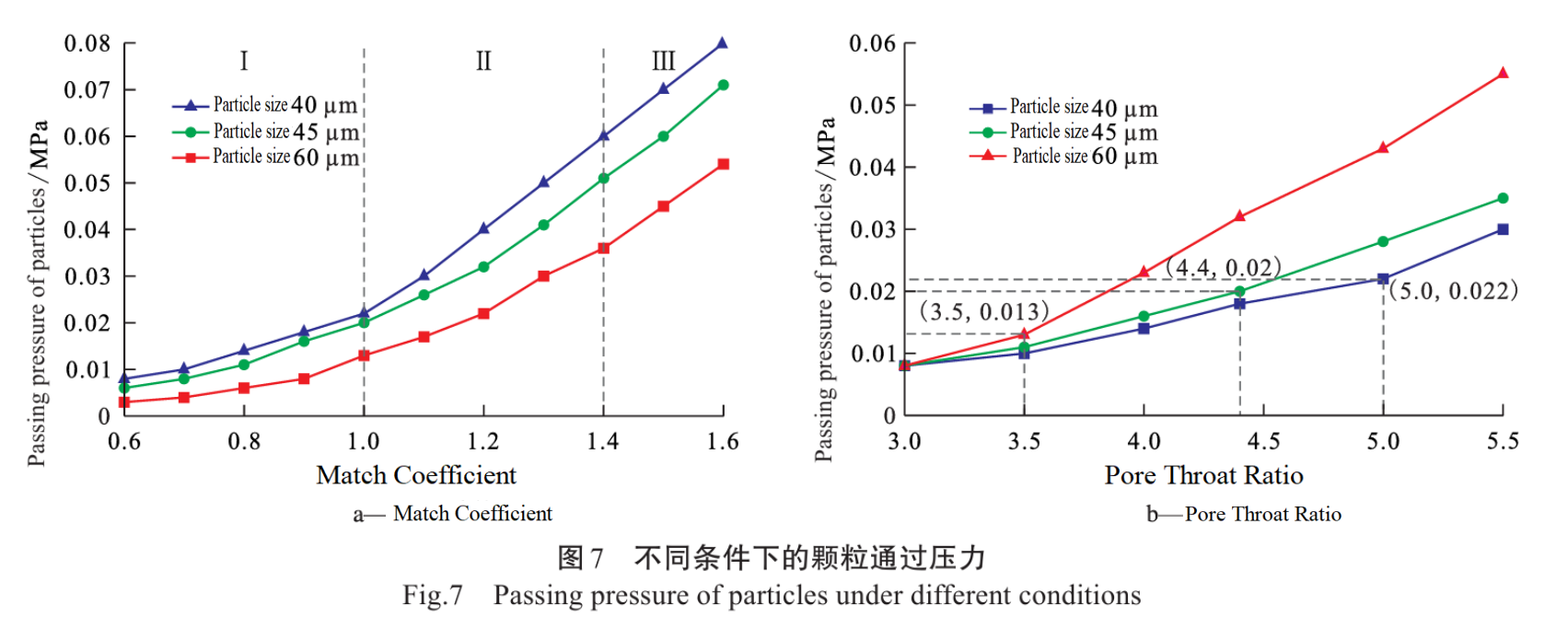Research on Sealing Performance of Heterogeneous Systems in Microchannels(Part 2)
2. Sealing Performance of Heterogeneous Systems at Pore Throats
Natural rock cores are composed of complex rock skeletons and pores, with pores and throats jointly forming the pore throat structure. Due to the lack of visibility and complex lithology of natural rock cores, in order to study the sealing performance of particles at the pore throat, the pore throat structure of natural rock cores is simplified into a pore throat model with different pore throat ratios, exploring the sealing ability of particles with different particle sizes in the pore throat, as well as the influence of matching coefficient and pore throat ratio on particle sealing performance.
2.1 Sealing Performance
The distribution of core pore throat diameter and particle size is different, so there are also differences in the sealing methods for different diameter pore throats with different particle sizes. There are two ways for particles to seal at the pore throat (Figure 4). From Figure 4a, it can be seen that three smaller particles aggregate with each other (not coalesced) to form a bridge body that enters the pore throat. Due to the particle size being smaller than the pore throat diameter and the instability of the bridge body, it splits when passing through the pore throat, which has a poor sealing effect. Therefore, this article will not conduct research. From Figure 4b, it can be seen that when a single larger particle enters the pore throat, due to the particle size being larger than the pore throat diameter and the stable structure of the particle itself, elastic deformation occurs when passing through the pore throat. Its shape changes from spherical to ellipsoidal, and it returns to its original shape when finally passing through the pore throat. For elastic sealing, due to the stable structure of the particles themselves, they exhibit the characteristic of temporary deformation and migration through the pore throat at the entrance of the pore throat. Their sealing performance at the pore throat is better than that of bridging sealing. The deformation and migration process of particles in the micro pore throat and the advantages and disadvantages of sealing performance of particles with different particle sizes are simulated.

As shown in Figure 2, the particles at the front end of the microchannel model can be stably generated. In order to simulate the elastic sealing process (Figure 4b), a micro pore throat structure model is constructed at the outlet of the microchannel model, allowing the heterogeneous system generated at the front end to enter the pore throat to study the flow characteristics of the heterogeneous system at the pore throat and the sealing performance of the particles. The particles generated by the front-end of the microchannel model flow through the micro pore throat structure model and transport through the entire process, realizing the simulation of particle deformation through the pore throat process (Figure 5).

Taking the flow characteristics of particles with a particle size of 60 μm at the 36 μm pore throat as an example to study the particle sealing performance. The deformation process of particles at the entrance of the pore throat and the pressure change at the entrance of the pore throat are shown in Figure 6. As shown in Figure 6a, the streamline at the entrance of the orifice throat is denser, indicating a higher flow velocity at this location. From Figure 6b, it can be seen that within a certain time range, due to the continuous and stable passage of particles through the pore throat, the pressure at the inlet of the pore throat shows a periodic trend of change. Based on Figures 6a and 6b, it can be seen that the entire process of particles passing through the pore throat and the pressure changes at each moment are as follows: from the particle distribution at time t1 in Figure 6a, it can be seen that at the 87th second, the second particle in the channel moves to the inlet of the pore throat. Due to the particle size being larger than the throat diameter, the particle shape changes at the inlet of the pore throat from circular to elliptical, and at this time, the inlet of the pore throat is blocked by particles, causing the pressure to increase from 0.012 MPa to 0.065 MPa; From the particle distribution at time t2 in Figure 6a, it can be seen that at the 90th second, the pressure increases to 0.065MPa, and the particle shape is sufficient to enter the throat. At 90-92.5 seconds, the particles move inside the pore throat, and the pressure at the inlet of the pore throat gradually decreases; From the particle distribution at time t3 in Figure 6a, it can be seen that at 92.5 seconds, the particles migrate out of the pore throat, and the elastic energy stored inside the particles is released, causing them to return to their original shape and the pressure to recover to 0.012 MPa. From Figure 6b, it can be seen that the pressure value before 80s, 0.01 MPa, is the pressure at which the homogeneous system flows through the pore throat, and the periodic peak pressure of 0.065 MPa is the minimum pressure at which the heterogeneous system passes through the pore throat. The particle sealing pressure is defined as the difference between the minimum pressure of a heterogeneous system passing through the pore throat and the pressure of a homogeneous system passing through the pore throat. Therefore, the sealing pressure of a 60 μm particle at the 36 μm pore throat is 0.055 MPa (Figure 6).

2.2 Matching Coefficient and Pore Throat Ratio
Taking into account the influence of the matching coefficient between particles and core pore throats and the ratio of pore throats on the flow characteristics of heterogeneous systems. The matching relationship between particles and core pore throats is the main factor affecting their sealing effect, and the pore throat ratio is an important indicator to describe the pore throat structure and characterize the ability of heterogeneous systems to pass through. The expressions for the matching coefficient and pore throat ratio are:

A study was conducted on the grouping of particles with different particle sizes, and the results are shown in Table 1. The matching coefficient and pore throat ratio were obtained from equations (5) and (6), and the particle pressure was obtained from the difference between the pressure of non-homogeneous systems and homogeneous systems. The three groups of particles with different particle sizes in Table 1 have one-to-one corresponding pore throat ratios. By changing the throat diameter, all solutions for the three groups of particles with different particle sizes were calculated with matching coefficients ranging from 0.6 to 1.66.

When particles in heterogeneous systems undergo elastic sealing at the pore throat, the sealing effect is optimal, and only within the optimal matching coefficient range can economic and efficient goals be achieved. Therefore, for three different particle sizes, the matching coefficient was distributed between 0.6 and 1.66 by changing the throat diameter, and the trend of particle passing pressure with the matching coefficient in this range was explored (Figure 7a).
Oil reservoirs in high or ultra-high water content development stages experience varying degrees of increase in core porosity and permeability under long-term injection water erosion. Therefore, it is important to study the flow characteristics of heterogeneous systems under different throat diameters. Using three different particle sizes to study the flow characteristics of heterogeneous systems, three control experiments were set up. By changing the throat diameter, the pore throat ratios were all 5.5, 5.0, 4.4, 4.0, 3.5, and 3.0, and the particle passing pressure at different pore throat ratios was obtained (Figure 7b).
In a channel with a pore diameter of 200 μm, it can be seen from the changes in pressure of particles with particle sizes of 40, 45, and 60 μm as a function of the matching coefficient (Figure 7a) that when the matching coefficient is 1.0, the three types of particles have different passing pressure values, and this value is used as the critical value for particle passing pressure. Divide the particles through the pressure change curve into three intervals: I, II, and III, with matching coefficients of 1.0 and 1.4 as the boundary. In interval I, the particle size is smaller than the throat diameter, and the matching coefficient is [0.6, 1.0]. As the matching coefficient increases, the increase in particle passing pressure is smaller and slower, indicating poor particle sealing effect. This interval does not meet the requirements of particle elastic sealing, so it is not considered; In interval II, the particle size is larger than the throat diameter, and the matching coefficient is [1.0, 1.4]. As the matching coefficient increases, the particle pressure increases significantly and the growth rate is fast, showing the elastic sealing process shown in Figure 4b. At this time, the particle and pore throat match well, and the particle can deform and migrate through the pore throat after temporary sealing, meeting the requirements of elastic sealing; In interval III, the particle size is larger than the throat diameter, with a matching coefficient of [1.4, 1.6]. As the matching coefficient increases, the particle pressure increases significantly and the growth rate is fast. At this time, the particle can seal the pore throat and deform through it. However, due to the large particle size and shape variation, fragmentation occurs at the outlet of the pore throat. After passing through the pore throat, its own structure will be damaged and split into smaller particles, which is particle aging and affects subsequent pore throat sealing. To preserve the particle sealing performance, this interval is not considered. The pressure of particles increases with the increase of the matching coefficient, and the optimal range of the matching coefficient is [1.0, 1.4].

When the pore diameter is 200 μm, it can be seen from the pressure changes of particles with particle sizes of 40, 45, and 60 μm under different pore throat ratios (Figure 7b) that the critical pressure value for particles with particle sizes of 40 μm is 0.022 MPa, corresponding to a pore throat ratio of 5.0 and a throat diameter of 40 μm. When the throat diameter decreases to 40-36 μm, the pore throat ratio increases to 5.5, which effective particle plugging can be achieved; The critical pressure value for particles with a particle size of 45 μm is 0.02 MPa, corresponding to a pore throat ratio of 4.4 and a throat diameter of 45 μm. When the throat diameter decreases to 45-36 μm, the pore throat ratio increases to 5.5, and the particles can achieve effective sealing; The critical pressure value for particles with a particle size of 60 μm is 0.013 MPa. At this time, the corresponding pore throat ratio is 3.5, and the throat diameter is 60 μm. When the throat diameter decreases to 60-43 μm, the pore throat ratio increases to 4.6, and the matching coefficient is 1.4. The particles can achieve effective sealing. When the throat diameter decreases to 43-36 μm, the pore throat ratio increases to 5.5. At this time, the deformation of the particles at the pore throat is too large, resulting in structural damage at the outlet of the pore throat. Therefore, this range is not considered. The particle passing pressure increases with the increase of pore throat ratio, and when the matching coefficient is 1.0, the critical value of particle passing pressure decreases with the increase of particle size.
3. Conclusion
A micrometer scale channel model was established based on the pore size distribution characteristics of natural rock cores in Daqing Oilfield. A non-homogeneous system flow model was established using the phase field method. Referring to the particle size distribution after swelling, the generation and sorting of three different particle sizes were simulated.
The simulation of the elastic sealing process of particles in the micro pore throat structure shows that during the continuous passage of particles through the pore throat, the pressure at the inlet of the pore throat shows periodic changes, and the particle sealing pressure is the difference between the pressure of non-homogeneous system and homogeneous system.
When the matching coefficients are [1.0, 1.4], the particles have good compatibility with the pore throat. The particles are temporarily blocked at the entrance of the pore throat and return to their original shape after transportation through the pore throat. The particle sealing performance is good, and this range is the best matching coefficient range for particles and pore throats.
When the pore diameter is the same, the particle passing pressure increases with the increase of matching coefficient and pore throat ratio, while the critical value of particle passing pressure decreases with the increase of particle size.
Interpretation of symbols
dc ——pore diameter,μm;
dp ——particle size,μm;
dt ——throat diameter,μm;
n——unit vector;
p——pressure,Pa;
p0 ——static pressure,Pa;
ti ——time,s,i=1,2,3;
uc ——Initial flow velocity at the horizontal inlet of the model,m/s;
ud ——Initial flow velocity at the vertical inlet of the model,m/s;
u0 ——wall velocity,m/s;
u1 ——horizontal inlet flow velocity of the model,m/s;
u2 ——vertical inlet flow velocity of the model,m/s;
δ——matching coefficient;
∂——pore throat ratio.
